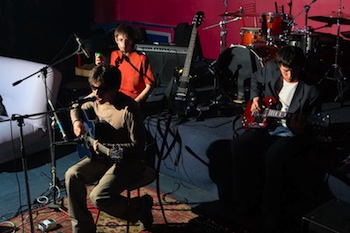No one song component lives in a vacuum — how well they work together determines the success of your song.
_____________
Download “The Essential Secrets of Songwriting” 6-eBook Bundle, and solve your songwriting problems TODAY.
_____________
 When you glimpsed the word “partnership” in the title of this article, you might have thought that this would be another post supporting the value of songwriting partnerships. And while I wholeheartedly support that notion, I’m actually writing about a different kind of partnership — in many mays, a more crucial one. The success of a song is directly related to how well the various elements “communicate” with each other. It’s a crucial songwriting principle.
When you glimpsed the word “partnership” in the title of this article, you might have thought that this would be another post supporting the value of songwriting partnerships. And while I wholeheartedly support that notion, I’m actually writing about a different kind of partnership — in many mays, a more crucial one. The success of a song is directly related to how well the various elements “communicate” with each other. It’s a crucial songwriting principle.
In music, no one component exists in a vacuum. Lyrics are great only if the melody and chord progressions perfectly support it. The melody only works if the underlying harmonies and lyrics give meaning to its shape. And chord progressions won’t be enough to exist on their own: no one goes down the street humming chords.
To solidify the relationship between the various song components, check the following tips, and see if your songs conform:
- Melody: High points in melodies should link up with emotional moments in lyrics. A melodic peak needs to have a lyrical reason. An important word doesn’t always need to sit at the absolute highest note of your phrase, but it should be close. Any easy analysis to do is to simply take any of your favourite songs and see what words have been placed at or near high points in the melody.
- Melody: A climactic high point is an important structural element that usually happens in the chorus. And that climactic moment is not just the highest point of the melody. In fact, it’s a “perfect storm” of melody, lyric and chord progression.
- Lyric: Good lyrics require you to consider rhythm and melody as strong partners. Rhythm plays an important role in the success of lyrics in the sense that proper word placement must allow for the natural rhythm of the words. Forcing words into melodies without thinking about the natural pulse of the text is disastrous for the song’s meaning, and can have the overall effect of making your song sound, frankly, a bit silly.
- Harmony: Strong and fragile chord progressions, used haphazardly, will confuse the listeners’ take on your lyric and melody. We know that fragile progressions (ones that are tonally vague and don’t strongly indicate any particular key) belong in verses and bridges. You can compromise the meaning of your song and the strength of your text, for example, if you use fragile progressions in a chorus.
- Harmony: The frequency of your chord changes (i.e., how long you stay on one chord before switching to the next one, called harmonic rhythm) has a lot to do with the overall energy level of your music. If your song lyric is gentle or evocative, you can destroy the feeling by changing chords too quickly. Also, music gains an unpleasant “panicky” feeling if the song is uptempo and the chords are changing quickly. Harmonic rhythm should be inversely proportional to tempo: the faster the song, the slower the harmonic rhythm.
There are lots of other ways that various song elements communicate with each other in a song. The point is that it’s important not to consider one element without thinking about how other components will affect it. As you work on your lyric, for example, think about important words and ideas that you want to convey, and then how you might use melody, rhythm, tempo, key, etc., to enhance it. Do that for all of your song components, and possibly you’ve got the makings of a great tune.
____________
PURCHASE and DOWNLOAD the e-books for your laptop/desktop











Pingback: ARTICLE LINK: Successful Songwriting: A Partnership of Song Components | Creative Music | Inspiring Musical Creativity